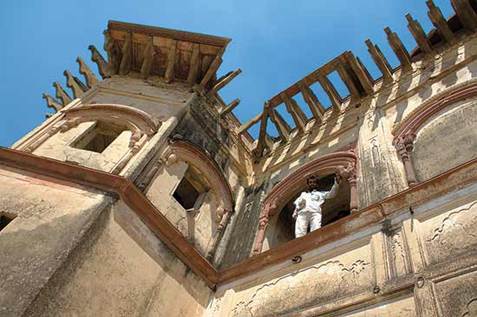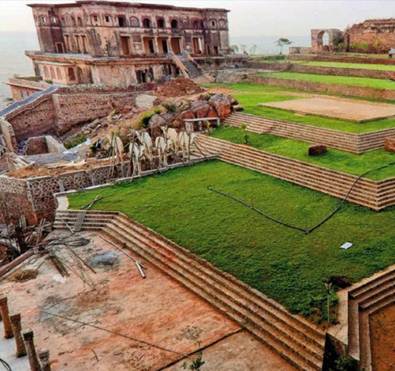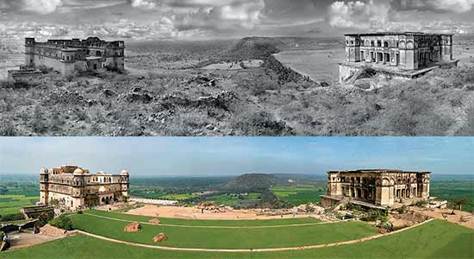One of first concerns is the main entrance
– a gigantic and rough archway which seems familiar the rest of new buildings,
employs stones carried from nearby hillside. “When we started digging to build
the main entrance, we found a wall which now matches with the main gate’s line
and by instinct, it guides us in right way” Aman said, because he and his
workers has discussed the entrance’s width (it has to be large enough for a
Volvo to go through easily).
Aam’s diligence has spread all around. He pointed
at a hoard storing half-broken arches (“from a palace that was older than
Tijara and collapsed at Bikaner”). He tried to collect 7 trucks of what I cloud
see as rubble. Yet it is the talent of Aman and Francis – they know exactly
where everything is going to join together. “Half-broken arches are all left-facing
so we hope to join them in a way that half of the arch is curved outside while another
half is done inside. After then, they will be used to form a pavilion showing
27 arches to combine with outside bar’s area”.

The
arches
We walked to Rani Mahal – a wonderful
space, high ceiling with dark corridor covering a small yard inside. In four
directions, tracks were leading to gloomy small rooms which are changed into guest
rooms. ”They used to be warehouses. We will install windows and jharokhas to
open them” Amam said.
“Let me guide you to swimming area,” he
shouted and jumped over many steps to get higher on the stair and from here we
could see a huge pit. “I have intention of making a waterfall pouring onto
these rocks. Alongside will be carved arches that open to the pool. Oh, do you
see that opening space? It is where lawns will be grown and outdoor bar giving free
look to the countryside. How about these alongside troughs? We are going to
plant bougainvillea…” Wherever he pointed at, all I could see is soil and
rubble that are mixed into a large terrain which had just been dug. He pointed
at the technical drawing for more detail. It was useless. To understand, I
might get back.

Terraced
lawns
August 2011
Six month later, the monsoon turned the
dirty track into a sticky swamp. This time, I sat in a small car which was
struggling desperately to get out of that dense mess while Aman’s SUV had
surpassed mine. We took it onto a mound when the car got a flat tire and it was
distant from ¼ of our way. Having to hike the rest of the road, I was rewarded
with splendid view during my walk to the summit. We were greeted by an
impressing entrance. “It is from Jodhpur”, Aman explained. He was with his
companion, Naynaa Kanodia painter who belongs to 20th-century class. Painters,
they have own galleries (“I want themed room and I wonder why not celebrate our
artists?”) Amrita Sher-Gil, Anjolie Ela Menon and Bharti Kher are among names
whose works were hung on walls.
Things have changed. Main entrance (from
Punjab) was still there. A boundary wall appeared nicely. “We always pay
attention to old castles, such as in Punjab, Haryana and Rajasthan” that are
being ruined and we collect then recycle as much as possible – main access,
windows and especial stone. It is why our restoration seems real, of course it
real”.
On way to Rani Mahal, terraced lawns were
expansive, below lay spa, kitchen and laundry rooms. In the middle, a pavilion
had been built with arches whose half is left-facing. In Rani Mahal, the inner courtyard
showed promising sight with growing vegetables. 4 storehouses on ground floor delivered
fresh sunshine through brand-new window frames. In upper courtyard, 2 suites (Anjoile
and Bharti) seemed nearly completed. They were big and not symmetrical, with cozy
and quiet corners giving intended attractions. “One of our issues was
installing ceiling fans; we didn’t realize that we would deal with 2-foot-thick
ceilings”. They also tried to keep bathroom of adjacent rooms close or one on
the other’s top for operating well pipes. “But when it is impossible, we do
what we can to curve the pipeline at minimum length”.
Entering further into courtyard, Aman
informed one of the rooms had been restored. It was Rani’s early storehouse
where there were thick shelves running alongside with walls to keep her dowry. “We
pulled out shelf and watched. The space is wide enough to turn into a guest
room. It’s Neemrana’s philosophy – restore for better use.” To illustrate his
view point, he led me into a wet shaft. “It used to be for old stair and now it
is perfect for an elevator”.
Another remarkable change was the swimming
pool. The muddy pit was replaced by a cement surface hemmed by plastic pipes. Stoned
steps spiraled down the hillside from where the pool was created led to a pool.
“The pool’s entire base will be covered by glass finish so that light will go
through it and refract” Aman said. “The effect is about to be significant”.
One more thing Aman was urgent to show us since
we arrived, and Yashas and I allowed ourselves to go downstairs and pass Hawa
Mahal. Going up to an obsolete stair, alongside a cold corridor, Aman stopped at
a dark cave’s mouth. He lit a torch and a wall, which was painted with
characteristic strokes of Anjoile Ela Menon, suddenly got into our sight. “It
is one of my favorite aspects” Aman talked with joy. Finally, there would be an
area for sunbathing, surrounding a water fountain and troughs.

The
past hotel (up) and the present one (down)
March 2012
Quiet introduction of Tijara fort-palace
has been launched. The government did agree for some money to fix the whole
dirty track. Rani Mahak’s 3 floors have been almost done. In ground-floor’s
courtyard is a garden with over-grown vegetables. Lawns are terraced, luxuriant
and well cut. There’s no arid land, like before. Flowers are blooming. The
history has been made again.
Tijara Hotel is in Alwar district,
Rajastha, distant from Delhi-Jaipur highroad (NH-8) and it takes 2-3 hours
driving from Delhi. The hotel is due to open in September 2012 and it first
servers 20 guest rooms. A room’s cost starts at $215, including breakfast.